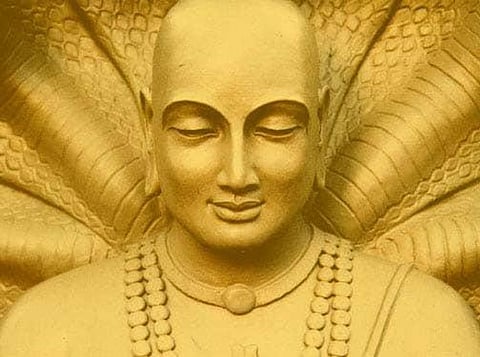
- Home
- न्यूजग्राम
- India
- World
- Politics
- Entertainment
- Culture
- Lifestyle
- Economy
- Sports
- Sp. Coverage
- Misc.
- NewsGram Exclusive
- Jobs / Internships

By Gaurav Sharma
And now Yoga, the very first line of Patanjali's Yoga-Sutra(s), holds a deep mystical meaning behind it (having engaged in all sorts of mundane activities up till now, it is now time for Yoga).
The name Patanjali itself has an aura of mystery attached to it. That one man could provide a wide-encompassing body of work in his life has bewildered Oriental scholars ever since they came across his profound texts.
Indeed, most outstanding scholars have been unambiguous in contending that the name Patanjali did not belong to one man, but to different geniuses.
In making that contention, the modern day scholars completely forget that in ancient India, it was but a common sight for a single man to possess diverse talents, much like the medieval Renaissance Man, Leonardo da Vinci.
The myriad meanings of Patanjali
The name Patanjali stems from a fable hypothesizing his birth. Legend has it that Shesa, the divine serpent who was the rest for Lord Vishnu, had incarnated as a snakelet and fell into the folded hands of a Brahmin.
Sanskrit commentators explain the word Patanjali in two ways. In the first instance, Patanjali is falling into folded hands. In the other interpretation, the meaning is conversed; Patanjali is the man for whom the folded hands are falling.
Etymologically, Patanjali is a compound word, a culmination of the word Patan or bank and Jal or water. Patanjali, is therefore, synonymous of a water bank.
Patanjali's comprehensive works
–Yoga Tradition
Patanjali is well renowned within the yoga world. While the process of yoga was being practiced as long back as 3000 BCE, it was Patanjali who codified or compiled the diversified and complex yoga practice into Sutras or thread like form, the modern day equivalent of a formula or aphorism.
Some people use Sutra in the singular form to highlight a single thread that is consistent with the yoga teachings of Patanjali. Others prefer using the plural form Sutras, to emphasize the various threads that weave a wholesome tapestry.
The Yoga-Sutra(s) of Patanjali were the first works to succinctly outline and elaborate on the art of Yoga meditation for self-realization. It is sometimes also referred to as Ashtanga-Yoga and Raja-Yoga, while others call it Kriya-Yoga, citing chapter two of the sutra(s).
Apart from succinctly summarizing the science of Yoga, Patanjali brought to light something very basic and enlightening.
"There have been many scholarly commentaries on the Yoga Sutras, but all the commentaries miss something very practical. Such commentaries can only satisfy the intellect, but do not actually help you beyond that.
'yogash chitta vritti narodha'–yoga is the control of the 'modifications' of the mind [1.2]. Narodha means control; there is no other English word for it. Control doesn't mean suppression, but channeling or regulating," says Swami Rama, one of the first Yogis to be inspected by Western scientists, while mentioning the novel contributions of Patanjali.
Taking the Samkhya philosophy to a higher pedestal
It is widely believed that the Yoga-Sutra(s) are based on the foundation of Samkhya philosophy, the dualist cum rationalist school of Indian philosophy. For example, historian Surendranath Gupta prefers calling Patanjali's commentary as Patanjala Samkhya, thereby basing it on Samkhya principles.
However, what distinguishes Patanjali from the Sankhya philosophy is the fundamental addition of principle of Isvara or God. Liberation, according to Patanjali, can be attained by surrendering to God. Devotion, represented by the syllable OM, is considered as the most efficient means to Moksha by Patanjali.
While Samkhya holds knowledge as the cornerstone of liberation, Patanjali considers mere intellectual knowledge as inadequate for achieving the ultimate aim of freeing oneself from the clutches of Maya or material energy.
"The two philosophies were in popular parlance distinguished from each other as Samkhya with and Samkhya without a Lord," says Max Mueller, the german-born Orientalist, while distinguishing between the two schools of thought.
Contributions to Grammar
While Patanjali is revered as a yoga guru, the fact that he was one of the three pioneering Sanskrit grammarians of ancient India, the others being Panini and Katyayana, has been obscured from public view.
Commenting on Katyayana's Varttika and Panini's Ashtadhyayi, Patanjali elaborated on selected rules of grammar in his masterpiece, Mahabhashya, or the great commentary.
The development of language was given a proper form by Patanjali. He carves out details related to phonology and accent with utmost ease and discusses etymology in depth, but leaves out syntax, as it is relatively redundant in the inflexional language that he scrutinized.
Distinction from Panini, Contemporary relevance
Panini's aim in Ashtadhyayi was to distinguish form and meanings from incorrect ones. Patanjali, on the other hand, possesses a greater metaphysical bent of mind. He clarifies ambiguity, keeps the pedagogical style rather concise, and focuses on keeping the text unadulterated.
Moreover, the writing style of Panini is much lighter. Religious intolerance, a thriving problem in the present day, is highlighted in his comments on conflicts between orthodox Brahmins and other heterodox groups, such as Buddhism and Jainism.
He describes the hostility between the groups as an incessant fight between a mongoose and a snake. Other events such as incursion and tribal areas also find a mention in Patanjali's words.
But perhaps what holds the greatest anodyne for the splintered minds of today is Patanjali's concept of Chitt Vritti Nirodha; stilling the modifications of the mind in order to experience higher dimensions of life (the fulcrum).
